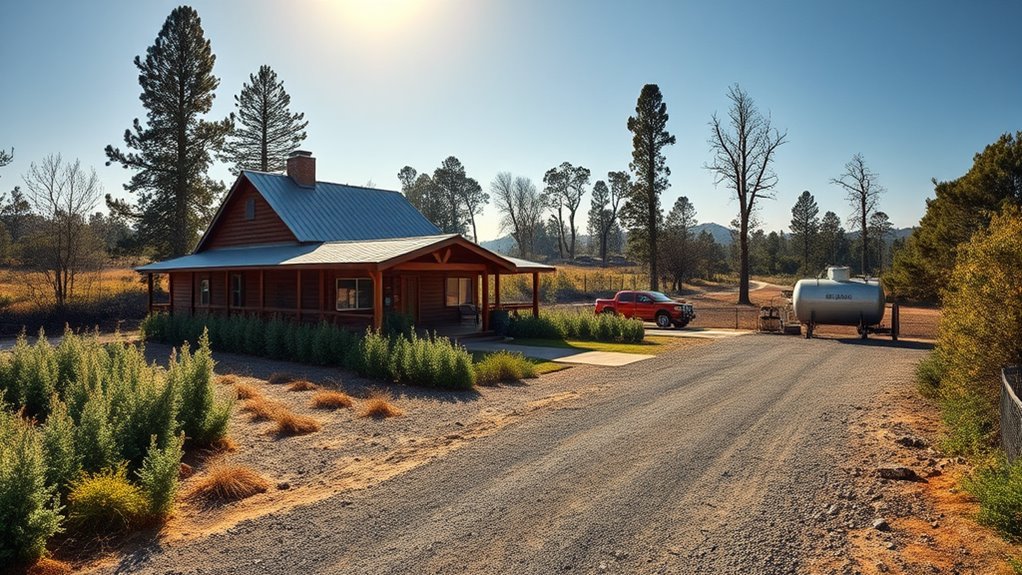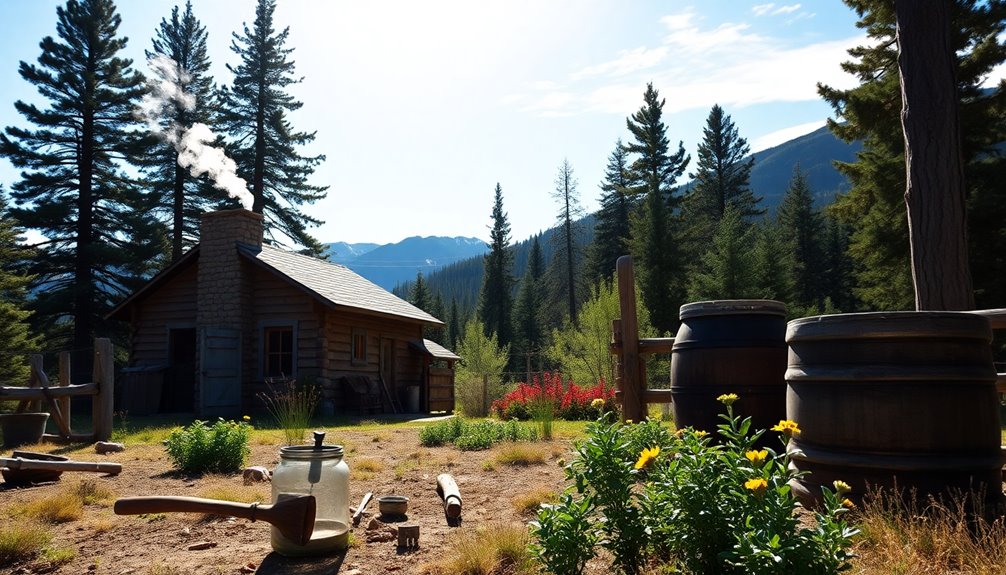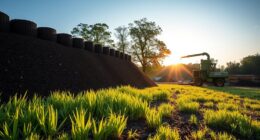To prepare for wildfires, create defensible space by clearing away dead vegetation, trimming trees, and using fire-resistant landscaping around your property. Develop a clear evacuation plan with designated routes and communicate it with family and neighbors. Maintain multiple communication devices and regularly test them. Combining physical safeguards with a solid evacuation strategy can notably improve your safety and property protection. Keep exploring this guide to learn more essential steps for wildfire preparedness.
Key Takeaways
- Clear dead vegetation and trim trees around your property to reduce wildfire fuel and create a defensible space.
- Use fire-resistant landscaping, such as gravel pathways and non-flammable plants, to minimize fire spread.
- Develop a detailed evacuation plan with multiple routes and designated meeting points for family members.
- Maintain clear communication protocols and keep emergency contacts updated for quick response during wildfires.
- Regularly review, practice, and update your defensible space and evacuation plans to ensure readiness.

Have you ever wondered how prepared you are for a wildfire? It’s a critical question, especially if you live in an area prone to wildfires. Preparing your home and family isn’t just about having a fire extinguisher or a first aid kit; it’s about creating a detailed plan that includes fire-resistant materials and reliable emergency communication. When it comes to your home’s safety, using fire-resistant materials for roofing, siding, and decks can greatly slow down the spread of flames. Materials like metal, brick, or specially treated wood can make your property more resilient, giving you precious extra minutes to evacuate or protect your property. These materials don’t just help during the fire; they also demonstrate your commitment to fire safety, potentially lowering insurance premiums and increasing the chances of your home surviving a wildfire.
Using fire-resistant materials like metal and brick can help protect your home from wildfires.
But even with a sturdy, fire-resistant structure, you need a solid evacuation plan. Part of this plan involves ensuring you can communicate with your loved ones and emergency services quickly and effectively. Reliable emergency communication means having multiple ways to stay informed—cell phones, two-way radios, or even a battery-powered NOAA weather radio. It’s essential to test these devices regularly, so you’re confident they’ll work when wildfire threats appear. Additionally, establishing a family communication plan helps everyone know what to do and where to meet if you’re separated. Keep emergency contacts updated and share your evacuation routes with family members, neighbors, and friends. Knowing your routes in advance prevents panic and delays during an emergency.
Creating defensible space around your home is another important step. Clearing away dead vegetation, trimming trees, and maintaining a safe zone free of combustible materials reduces the risk of wildfire spreading directly to your property. Combine this with fire-resistant landscaping—like gravel walkways and non-flammable plants—and you further protect your home’s perimeter. Remember, wildfire preparedness isn’t just about reacting when a fire is near; it’s about proactive measures that make your property less attractive to flames and easier to defend. Incorporating fire-resistant landscaping can significantly enhance your home’s ability to withstand wildfire threats.
In all these efforts, don’t forget the importance of staying informed. Keep yourself updated with local fire alerts and evacuation notices. Having a set plan for emergencies, knowing how to communicate, and using fire-resistant building materials all work together to make you better prepared. Wildfire seasons can be unpredictable, but with thoughtful planning and preparation, you can greatly improve your safety and that of your loved ones.
Frequently Asked Questions
How Often Should Defensible Space Be Maintained?
You should maintain your defensible space regularly, ideally every year, to guarantee firebreak maintenance and vegetation clearance are effective. Check for overgrown shrubs, dead branches, and other combustible materials that can fuel a fire. Trim trees and clear dry grass or leaves, especially before the fire season begins. Consistent upkeep helps create a safe buffer zone, reducing fire risk and giving you better protection if a wildfire approaches.
What Materials Are Best for Fire-Resistant Landscaping?
Opt for fire-resistant plants like succulents, lavender, and rockrose, along with non-combustible landscaping materials such as gravel, pavers, and fire-resistant mulch. These choices help reduce fire risks, resist ignition, and create a buffer around your home. Prioritize low-growing, moisture-loving plants, and avoid highly flammable materials. By selecting fire-resistant plants and landscaping materials, you enhance your defensible space, protect your property, and improve safety during wildfire threats.
How Can I Find Local Evacuation Centers?
You can find local evacuation centers by checking community alerts and emergency management websites. Sign up for alerts to get real-time updates on nearby shelters and evacuation routes. Your local government often provides maps and lists of designated centers. Additionally, contact your local fire department or visit their website for detailed information. Staying informed guarantees you know where to go quickly during an emergency.
What Should I Include in a Wildfire Emergency Kit?
You should include fire-resistant tools like gloves and goggles, a flashlight, and a multi-tool in your wildfire emergency kit. Also, pack enough water, non-perishable food, and personal hygiene items. Don’t forget emergency communication devices like a charged cellphone, portable charger, and a battery-powered radio. These essentials guarantee you’re prepared to protect yourself, communicate effectively, and stay informed during a wildfire emergency.
Are There Financial Assistance Programs for Wildfire Damage?
Like a beacon in the fog, financial aid can guide you through wildfire recovery. You might qualify for disaster grants to help rebuild and should file insurance claims promptly to cover damages. Local agencies and federal programs often provide assistance, so check with your state’s emergency management office or FEMA. Staying proactive guarantees you don’t navigate this storm alone, and support will help you rebuild what’s lost.
Conclusion
By taking the time to create defensible space and an evacuation plan, you’re acting like a true hero in this modern-day Wild West. Remember, preparedness isn’t just about fighting fires with your trusty water bucket; it’s about staying one step ahead, even if it means channeling your inner cowboy. So, stay vigilant, stay safe, and don’t wait for a smoke signal—be ready now, before Mother Nature throws a hissy fit.










